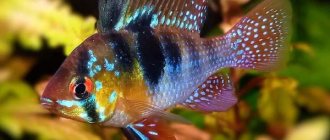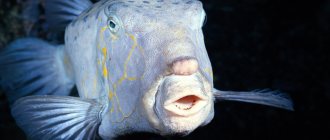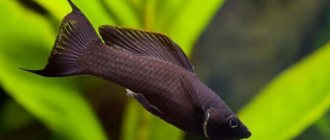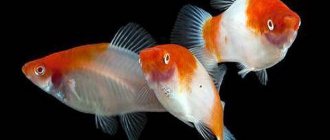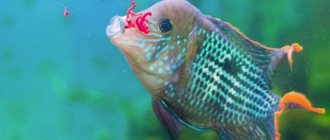The variety of both marine and aquarium fish is truly countless, so identifying the most beautiful of them is not an easy task. Underwater inhabitants compete with each other in a variety of colors and saturation, and some have long “migrated” to home and office aquariums, beginning to gain popularity in a new environment. Many fish breeders can devote themselves to watching the colorful aquatic inhabitants for hours and this is not surprising, given the fact that this kind of activity helps a person to relax, move away from problems and find inner harmony. In general, an aquarium in a person’s home can serve as a real “cure for nerves.”
Today we invite you to get acquainted with underwater inhabitants, considered the most beautiful in the world.
Parrot fish
The parrotfish has a jaw shaped like a bird's beak. She gnaws coral reefs with her mouth.
These fish come in both aquarium and large specimens that grow up to two meters in length. They come in different colors - mostly bright tropical shades predominate.
Blue surgeon
This fish gained worldwide popularity by playing one of the main roles in the Disney cartoon Finding Nemo. The stunning appearance of this underwater inhabitant is given by its blue color combined with black splashes and a bright yellow accent. The fish owes its unusual name to its spines, sharp as a medical scalpel. The “weapon” is hidden in special recesses on the sides of the tail peduncle, and in dangerous situations it can be used against the intended enemy and cause serious wounds.
Based on numerous comments on the Internet, tourists most often receive “fish injuries” after contact with an aquatic “surgeon.” Most representatives of this family prefer to live alone and can react aggressively to relatives and other underwater inhabitants. However, there are also non-conflict species that will get along well with any neighbors, focusing on searching for food and looking at the scenery.
Moorish idol
This fish with a disc-shaped body has long been recognized as one of the most beautiful in the world. This title is largely due to the stunning combination of white, black and yellow sections. Due to its striking external features, the image of the Moorish idol is often found in fine art.
Unfortunately, the increased attention of poachers to this species has brought it to the brink of extinction, which is why the fish can very rarely be found in aquariums. This graceful underwater resident is considered one of the most expensive ornamental fish and has the lowest survival rate in captivity.
5. Nudibranch mollusk Glaucus
When we hear the word “mollusk,” we are all used to imagining something slippery and reptile-like, which obviously does not evoke positive emotions. However, not all representatives of this family will scare you away. Nudibranchs resemble a mobile underwater flower, changing shape from time to time, and with proper lighting, giving off a pleasant blue neon glow. But they are used to hiding their beauty, they are extremely difficult to discover, not to mention photographing, but persistent divers revealed it to the world, and we shared this with you by compiling a list that includes the most beautiful fish in the world.
Inhabitants of a spacious aquarium
If the owner has purchased a large (at least 250 liters) container, then he has many options for filling it. You can put whole families of fish in such an aquarium. Attention should be paid to the dimensions and mobility of the inhabitants, and also be sure to learn about their individual characteristics:
- toxicity;
- food preferences (predators can become a threat to more peaceful neighbors);
- Do they harm vegetation and corals, etc.
Under no circumstances should you buy the first fish that catches your attention - even if it is incredibly beautiful, it is better to find out more about it. Sea fish are not a cheap pleasure, so it will be very unpleasant and disappointing if they die, get sick, or experience discomfort in their new home and constantly hide.
Lionfish
Many people believe that beautiful women are poisonous bitches who should not be messed with. In the case of humans this may be an exaggeration, but in the marine world this rule is rarely broken. Another proof of this is the lionfish - one of the very poisonous fish.
Looking at this creation, it seems that its appearance is the result of the work of a talented artist. Inexperienced divers are always strongly warned that getting too close to this beautiful sea fish can end sadly. The fact is that the needles at the ends of the fins are quite sharp; they can easily pierce the skin. Immediately after this, concentrated poison enters the body, causing paralysis of the respiratory and skeletal muscles.
With such symptoms, it is very difficult to get to the shore without outside help, so a person may drown. But you shouldn’t run away in panic when you notice such a beauty next to you. The lionfish is not aggressive towards humans; it never attacks divers it encounters without a good reason. She can only bite if she is stepped on or grabbed with her hands. Therefore, you can enjoy the beautiful creation of nature without contact with complete peace of mind. Moreover, the lionfish reacts quite smoothly to people filming it with photo or video equipment.
Tourists and local residents immediately notice the lionfish in the thickets of corals, but the inhabitants of the deep sea, on which this species feeds, do not always distinguish it from the background of bright colors. This allows the fish to camouflage itself by standing motionless in the water. She blends into the landscape, and meanwhile, prey swims up to her, unable to notice the dangerous beauty in a timely manner.
Imperial angel
The fish with the romantic name is rightfully considered one of the most beautiful inhabitants of the ocean depths. The body of this underwater angel is replete with bright yellow stripes with an orange tint, and its emerald head is “put on” a sophisticated mask around the eyes, which has become a characteristic feature of the fish. An interesting fact is that the imperial angel changes its color throughout its life: young individuals are distinguished by their black color with white and blue stripes.
Mandarin duck or Chinese snapper
This inhabitant of the water depths received its name due to its bright and elegant coloring, similar to the robe of an imperial Chinese mandarin - an official. However, due to its extremely colorful appearance, some have dubbed it a “psychedelic fish.” Its color combines black, green, blue, light blue, orange and yellow. Despite its popularity among aquarists, the mandarin duck is also the most whimsical in terms of keeping, since its feeding habits are quite specific.
Loaches
The loach family of aquarium inhabitants is brought from countries with a tropical climate. Such bottom-dwelling fish are predominantly nocturnal and sedentary. They prefer to stay in artificially created caves. At the first danger, loaches raise their spines, which can cause problems during the process of cleaning the aquarium. This group sometimes includes a similar-looking group of aquarium loaches.
The catalog of loach fish that you can keep at home includes:
- Acanthocobitis molobrion;
- Acantophthalmus Myers;
- Ambastaia nigrolineata;
- Amur loach;
- Bocilia dwarf.
Keeping such fish at home is quite difficult. They are not recommended for beginning aquarists. If the wrong conditions are created, the inhabitants of the aquarium may die.
Tetraodon
This extraordinary fish can perhaps be considered one of the most spectacular and unpredictable inhabitants of the depths of the water. It has smooth olive-green or brown skin and a pear-shaped shape that can inflate into a ball and also bring the spines that replace scales into a vertical state. This species has never been of interest to breeders, so it has retained its naturalness.
Triggerfish Picasso / Rhinecanthus aculeatus
The triggerfish has an unusual, even strange coloring. The belly is almost white, but the back is greenish-olive in color. A black stripe with a bluish border runs through the eyes, as if separating the head from the body.
The inhabitant of the Indian-Pacific region is quite aggressive, but wastes its aggression mainly on its relatives. This unusual fish loves to swim in warm, shallow waters, among reefs and rock crevices.
5
Pantadon
This representative of the marine fauna has several names - pantadon, mothfish and butterfly fish. With its bright appearance, it really resembles a tropical butterfly soaring in warm waves. Pantadons live near reefs, where the water is very well heated by the sun.
In addition to its unusually bright lemon coloring, the butterfly fish is memorable for its elongated mouth. This shape is not needed for kissing, but to make it easier to get food for yourself: with elongated lips it is better to penetrate any cracks and cracks of the underwater reefs.
The bright coloring, for which this marine species is so valued by people, is needed by pantadons for camouflage. For aquatic life, seeing these bright, beautiful fish, their bodies blend into the colorful landscape of the coral thickets. To make the similarity even more obvious, there are black spots in the tail part, lemon or orange in color.
Most often, pantadons live in schools, but when divers meet couples, this means that the fish have begun their mating season and love is in full swing. At this moment they are most vulnerable, so they are often caught by local fishermen. The fact is that tourists consider this dish exotic and pay a lot of money for it. But eating such a fish dish is very risky, because after the pantadon eats particles of poisonous reefs, the meat also becomes poisonous. It is impossible to die from this, but you can easily get severe poisoning.
Ternetia Glofish
Another genetically modified species obtained using the DNA of a sea jellyfish. The “basis” for luminous tetras was black tetras or ternets (Gymnocorymbus ternetzi).
In 2012, a new electric green glofish appeared. In addition to the electric green, the following thorns were obtained:
- cosmic blue;
- red starfire;
- sunny orange;
- galactic purple;
- pink moonrise.
Genetically modified fish differ little from their ancestors. Glofish tetras are also hardy, unpretentious, with the same behavior and even lifespan. They eat any food offered. Colored tetras are hardy and recommended for beginners. They like to live in groups of 6-8 fish.
Seal harness. Pterapogon kauderni
Photo credit: / CC BY-SA
The homeland of this unusual fish is the Indonesian island of Bangai. Lives mainly in large groups of up to 500 individuals.
It stands out among other exotic species for its large caudal and dorsal fins, which have black stripes. Convex eyes on a relatively small body indicate that the fish are very active in the dark.
10
Clown botia (Chromobotia macracanthus)
These bottom fish belong to the Loach family. The main body color is yellow-orange. Against this background there are three transverse black stripes. They have the shape of a wedge that tapers towards the belly of the fish. Their coloring will not leave anyone indifferent - it attracts and makes the fish very popular. And in some countries these fish are called tiger bots.
To keep clowns you need a fairly large aquarium. Adults grow up to 25 cm. This is a schooling fish, it is better to keep it in groups. You also need to worry about organizing the space inside the aquarium - these fish love to hide in grottoes as a whole flock. It is better to make the lighting dim. Neighbors can be almost any fish of approximately the same size, even some types of aggressive cichlids.
Horned Zankle
The horned zankle has another beautiful name - the Moorish idol. This species has miraculously survived to this day, since all other representatives of this family have already become extinct. Paleontologists believe that in prehistoric times, horned zankles were much larger and reached a size of 2-3 meters, not 22 cm, like modern specimens. It would be nice to meet such beauties now with alternating black and yellow stripes of enormous size, but modern Moorish idols are just babies compared to their prehistoric relatives.
The unusual scales give the horned zankle a special beauty. It is very small, and on each individual segment along the upper surface small outgrowths are noticeable, which together make the structure of the scales look like fine sandpaper. Because of this, the sun's rays penetrating through sea water are reflected on it in a special way, so this spectacle is truly unforgettable. The males are the most beautiful and colorful, the females are more modestly colored, because the male for mating is chosen precisely according to the severity of the coloring.
Afyosemion
These fish are representatives of spawning carp-toothed fish, which are also called “killifish”. To date, several dozen species of Afiosemion have been described (90 species), all of them have very diverse and original colors. It ranges from sky blue to fiery red. This type of fish is very hardy, which is due to the extreme conditions in which they live in their natural habitat. They have to deal with strong temperature changes and even drying out of water bodies; changes in water parameters are frequent. Life in conditions of alternating seasons of drought and rain has hardened the Afiosemions. Fish of this species have a slender and elongated body. The dorsal fin is slightly offset towards the tail. And the tail has an unusual shape in the form of a trident. To make it more convenient to catch insects that fall into the water, nature provided them with a directional
up the mouth. An aquarium with a volume of about 60 liters is optimal for keeping aphiosemions. Their lifespan is 2-3 years. Fish of this species are quite peaceful and get along well with other types of peace-loving fish. But it is not recommended to select fish with veil fins as neighbors for them, since Afiosemions can bite them.
Gnome Gourami
Dwarf Gourami fish
This fish is one of the smallest ornamental fish that can be found, with a body length of up to 5 cm. It was first discovered in 1822 in South Asia, near India, Pakistan and Bangladesh. Gourami live in areas with stagnant water or weak currents, such as lakes and streams. Its bright threads, like small reflectors, exist for a reason. Since visibility conditions in their natural habitat are not good, the fish uses its filamentous whiskers to identify its family members.
✰ ✰ ✰
15
Tulle apogon
The tulle apogon takes an honorable eighth place in our list of aquatic beauties. This fish mainly lives in the coastal waters of Indonesia. The species is listed in the Red Book, as there is a high probability of its extinction. This is primarily due to human fishing activities on an industrial scale. The tulle apogon can exist both in natural and artificial conditions, so avkariumists are also “hunting” for it. These fish are unusual not only for their shape and coloring. Before mating, the male actively courts the female. After laying eggs, the male is guarding his future offspring.
Scat Motoro Leopoldi
This freshwater resident, which has a contrasting velvety black coloration with white spots, is popular among collectors due to its spectacular appearance and unpretentiousness. By the way, fish is also considered one of the most expensive - its cost sometimes exceeds two thousand euros. When handling this stingray, care should be taken, since if a fish is pricked by a fish's spine, a long-healing painful wound will form on a person's skin.
The fish looks especially impressive in aquariums that imitate the seabed, and the volume of the container should allow it to swim freely. Motoro Leopoldi gets along well with fish living in the upper layers, but can be aggressive towards individuals of the opposite sex.
gold fish
There are more than 120 widespread and rare species of goldfish in nature. The modern heroine of the fairy tale of the same name may have an unusual tail, eye and body shape, changed during centuries of hybridization and selection. The most common colors of goldfish are gold and red, but individuals can also be found in black, white and pinkish colors.
Discus
In nature, this beauty cannot be found in noisy bodies of water. As a habitat, it prefers calm coastlines in the shade, where there is no current. Discus is considered one of the most beautiful tropical fish, and due to its enormous popularity in the aquarium hobby, they are also called the kings of aquariums. The primary body colors of discus are quite varied, ranging from dark brown to greenish shades. These fish are also known for their ability to recognize their owner's face and accept food from their hands.
Predators
Many aquarium owners pay almost no attention to predator fish, but in vain! Some fish of this type are almost non-aggressive, especially towards other aquarium inhabitants larger than themselves. However, their maintenance is closely related to the difficulties of meeting their nutritional needs, as well as the need to maintain the quality of the pet's aquarium home. A house for such aquarium inhabitants should be at least 300 liters.
You can keep aquarium predators in your apartment, such as:
- Red-bellied Piranha;
- Half erased;
- Belonesox;
- Tiger perch;
- Spiny eel;
- Dimidochromis;
- Toadfish;
- Golden Leopard;
- Aravana;
- Exodon;
- Carapace;
- African pike.
Maintaining such aquarium inhabitants is not the cheapest, so starting them is not recommended for novice collectors.


